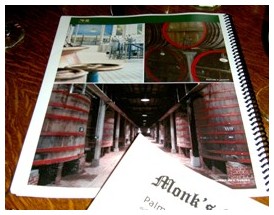Rudi Ghequire & the Rodenbach Philosophy

 The back bar at Monk’s Cafe in Philadelphia glowed with that soft lighting, so characteristic of late night vitality. This room, surrounded with dark wood and ornate wall tapestries, took on a sublime feel as my well-worn Fossil timepiece ticked onward toward midnight. Despite the late hour, Rudi Ghequire (pronounced heu-kee’-rah), Manager and 27-year Brewmaster of Rodenbach in Roeselare, Belgium, had agreed to meet with this Beer Fox to talk about Rodenbach and its philosophy, process, and products.
The back bar at Monk’s Cafe in Philadelphia glowed with that soft lighting, so characteristic of late night vitality. This room, surrounded with dark wood and ornate wall tapestries, took on a sublime feel as my well-worn Fossil timepiece ticked onward toward midnight. Despite the late hour, Rudi Ghequire (pronounced heu-kee’-rah), Manager and 27-year Brewmaster of Rodenbach in Roeselare, Belgium, had agreed to meet with this Beer Fox to talk about Rodenbach and its philosophy, process, and products.
“Rodenbach is the missing link between beer and wine,” he stated with emphatic authority, early in our conversation. As the son of a farmer, food had always been an important part of his life, and “brewing is a food industry,” he said. Rudi has a huge repertory of knowledge in both beer and wine and can speak with authority on either subject. The late Beer Hunter Michael Jackson frequently stated, “Rodenbach Grand Cru is the most refreshing beer in the world.” I wanted to discover the secrets behind this Belgian classic. What shaped its development into one deserving such impressive laurels?
Beer philosophy among brewers takes on a seriousness that parallels religious belief. The proof is in the glass, and my Grand Cru tulip displayed a nebulous burgundy body with ethereal eggshell head, while a tart profile of vine, vanilla and earth seductively filled the air. A beer of this caliber could only be crafted by a well-seasoned master, and Ghequire displays a salient knowledge that confirms him as a leading authority. His methodology displays strong roots in historical record that merges with state-of-the-art equipment and old-world traditions, all of it based on a philosophy that lives in this gap he spoke of earlier – that missing link between beer and wine.
Rudi Ghequire’s philosophy upholds several principles that, he believes, define Flemish brown/red ale, principles that would be hotly debated in the American brewing scene. This style is strongly based on acidic flavors, where the bitter bite of hops has no place. Archival evidence indicated that hops, and the bitterness associated with them, were introduced into beer by the Normans, a people with roots in Scandinavia who moved into Northern France and England. Prior to this, bitterness in food and drink was avoided, particularly for children, due to its association with poisonous currants and herbs. Populations from the North were more accepting of bitterness than those from the South, and a widening gap occurred between the beer-loving North and the wine-loving South.
Ghequire asserts that acid and bitter do not belong together, so hops are merely used to take the edge off, with a target IBU level of 7-8. During brewing, the pH of Rodenbach is maintained at 3.2 to 3.3. If you consider that vinegar has a pH between 2.0 and 3.0, and orange juice typically hovers between 3.0 and 4.0, you have a good idea of how Rodenbach’s tart profile feels on the tongue. It undergoes two fermentations with a complex combination of yeast strains and lactobacilli in stainless steel fermentation tanks; then, it is lagered for 4 weeks, bringing the pH between 3.9 and 4.0. At that point, the lactobacilli have become dormant, and do not have strength enough to start up again in the next phase.
A period of maturation on wood follows. Although some have interpreted this as a third fermentation, no additional yeast is added, so the nuances achieved are more accurately described as seasoned cultivation. Aging in Rodenbach’s carefully maintained oak foeders contributes tannins that result in the dense mahogany signature hue, while exposure to the scraped wood surfaces within the vessel releases flora that impart acetic acid and contributes vinous flavors, vanilla, and spices to the slowly developing character.  You may call them vats, tuns, vessels, or foeders; regardless of the term used, Ghequire emphatically insists that this wood aging is an absolute necessity when making Flemish brown/red. Many Americans insist they can craft this style without the floor space and traditional tun-aging used at Rodenbach, but the complexity will never be accomplished without this step.
You may call them vats, tuns, vessels, or foeders; regardless of the term used, Ghequire emphatically insists that this wood aging is an absolute necessity when making Flemish brown/red. Many Americans insist they can craft this style without the floor space and traditional tun-aging used at Rodenbach, but the complexity will never be accomplished without this step.
Rodenbach has 294 vessels that each hold between 3,000 to 15,000 gallons, although most hold 180 hectoliters, approximately 4,760 gallons. Eighteen tuns hold 650 hectoliters each. Two coopers are employed full time to open, inspect, scrape and maintain these vessels that average 8 cm in thickness, the oldest of which is 150 years. Even with such an aggressive schedule, each foeder will be opened only once every 50-60 years.
After 18 months to 2 years on wood, a gentle acidity is left. Because there are different amounts of oxygen in the vessels, flavors will vary between vats. If a batch is perfect upon sampling, it will not be blended, but will be released as a Limited Edition of that vintage. Classic Rodenbach is a blend of 75% young beer, finished with 25% beer that has the maturity of 2 years on wood. Grand Cru usually has a longer maturation time, and is a blend of several foeders that have been aged for 24 months, resulting in flavors of sour dark cherries, tannins, and a quenching dryness.  The history of Belgian brewing can be traced back to 1545, the source of traditions upon which Rodenbach was built. The four brothers Rodenbach (Pedro, Alexander, Ferdinand and Constantijn) invested in a small brewery in Roeselare, Belgium in 1821, but Rodenbach’s current traditions of brewing beer and aging it on wood were not implemented until 1878. Eugene Rodenbach, who had learned the art of blending beer and wood aging in his travels to England, spawned great growth and the famous philosophy for which Rodenbach has become world renowned.
The history of Belgian brewing can be traced back to 1545, the source of traditions upon which Rodenbach was built. The four brothers Rodenbach (Pedro, Alexander, Ferdinand and Constantijn) invested in a small brewery in Roeselare, Belgium in 1821, but Rodenbach’s current traditions of brewing beer and aging it on wood were not implemented until 1878. Eugene Rodenbach, who had learned the art of blending beer and wood aging in his travels to England, spawned great growth and the famous philosophy for which Rodenbach has become world renowned.
After Eugene’s death, the brewery was sold to a partnership, unrelated to the family lineage. Equipment eventually fell into a state of decline and by the latter half of the 1900s its future had become shaky and uncertain. It was not until 1998, when it was brought under the umbrella of Jan Toye’s independent Palm Breweries, that Rodenbach became renewed with new equipment and plans for expansion. Toye wanted to ensure the future of this brewery – to rescue this priceless part of the brewing world - and has proven his commitment with the construction of the new Meura Brewhouse in 2001, a visitor center, and a beautiful café in the town square, along with a new relationship with Latis Imports and assertive marketing for Rodenbach and the other world-class brands in his portfolio including Palm, Steenbrugge and Boon. With Rudi Ghequire at the helm of Rodenbach’s brewhouse, the unique character, so classically Rodenbach, is ensured through the hands of a master.
Cheers!
Photos are (from top): Rudi Ghequire, Brewmaster of Rodenbach; Booklet at Monk's Cafe showing the Maturation Vessels at Rodenbach, Roselare, Belguim; Beer Fox Carolyn Smagalski with Jan Toye of Palm Breweries (at Monk's Cafe, Philadelphia)
You Should Also Read:
Secrets of Belgian Style Ale - Dubbels & Tripels
Trappist Beer - The Select Seven
Biere de Garde - The Best Kept Secret of French Flanders

Related Articles
Editor's Picks Articles
Top Ten Articles
Previous Features
Site Map
Content copyright © 2023 by Carolyn Smagalski. All rights reserved.
This content was written by Carolyn Smagalski. If you wish to use this content in any manner, you need written permission. Contact Carolyn Smagalski for details.



